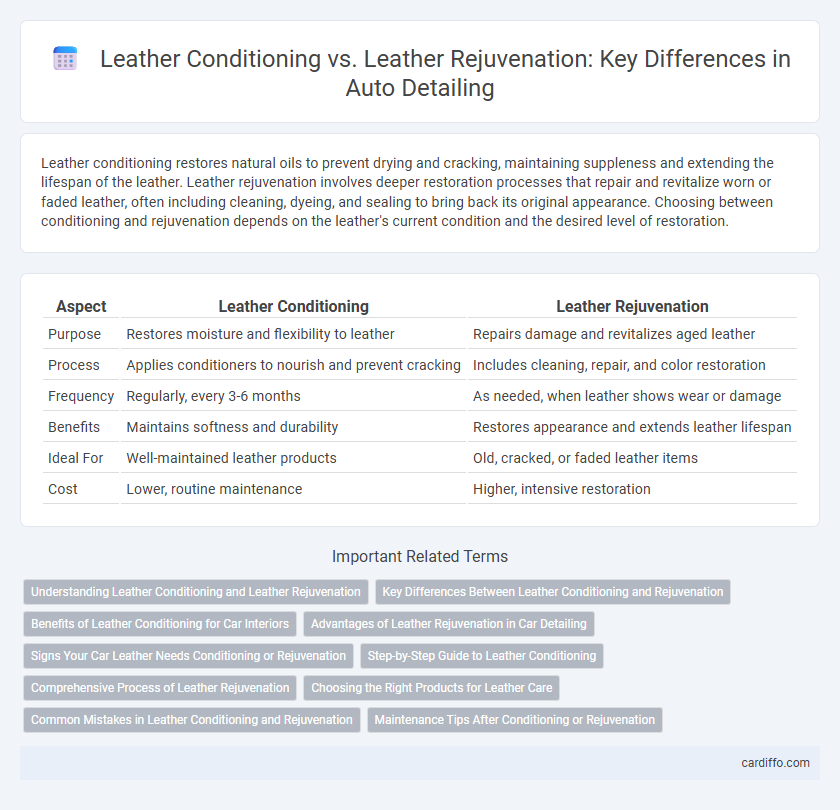Leather conditioning restores natural oils to prevent drying and cracking, maintaining suppleness and extending the lifespan of the leather. Leather rejuvenation involves deeper restoration processes that repair and revitalize worn or faded leather, often including cleaning, dyeing, and sealing to bring back its original appearance. Choosing between conditioning and rejuvenation depends on the leather's current condition and the desired level of restoration.
Table of Comparison
| Aspect | Leather Conditioning | Leather Rejuvenation |
|---|---|---|
| Purpose | Restores moisture and flexibility to leather | Repairs damage and revitalizes aged leather |
| Process | Applies conditioners to nourish and prevent cracking | Includes cleaning, repair, and color restoration |
| Frequency | Regularly, every 3-6 months | As needed, when leather shows wear or damage |
| Benefits | Maintains softness and durability | Restores appearance and extends leather lifespan |
| Ideal For | Well-maintained leather products | Old, cracked, or faded leather items |
| Cost | Lower, routine maintenance | Higher, intensive restoration |
Understanding Leather Conditioning and Leather Rejuvenation
Leather conditioning involves applying specialized oils and creams to maintain moisture, prevent cracking, and preserve the leather's flexibility and appearance. Leather rejuvenation focuses on restoring aged or damaged leather by repairing surface wear, filling cracks, and revitalizing color using advanced treatments and dyes. Understanding the differences helps in selecting appropriate care techniques to extend leather life and enhance durability.
Key Differences Between Leather Conditioning and Rejuvenation
Leather conditioning focuses on maintaining the leather's natural oils and moisture to prevent cracking and drying, primarily using conditioners and moisturizers. Leather rejuvenation involves a deeper restoration process that repairs worn or damaged leather by restoring color, texture, and suppleness, often utilizing dyes and specialized treatments. The key difference lies in conditioning being a preventative maintenance step, while rejuvenation is a corrective process aimed at revitalizing aged or damaged leather surfaces.
Benefits of Leather Conditioning for Car Interiors
Leather conditioning enhances the durability and appearance of car interiors by deeply moisturizing the leather, preventing cracks and drying caused by sun exposure and temperature changes. It maintains the suppleness and color vibrancy of the leather, ensuring a luxurious and well-preserved look over time. Regular conditioning also protects against stains and wear, extending the lifespan of premium leather surfaces in vehicles.
Advantages of Leather Rejuvenation in Car Detailing
Leather rejuvenation in car detailing restores the leather's natural oils and suppleness, preventing cracks and extending the lifespan of car interiors. This process enhances the appearance by deeply penetrating the leather, resulting in richer color and improved texture compared to mere conditioning. Rejuvenation treatments also provide long-lasting protection against wear, UV damage, and fading, making them superior for maintaining premium leather surfaces.
Signs Your Car Leather Needs Conditioning or Rejuvenation
Fading, cracking, and stiffness are common signs your car leather requires conditioning to restore moisture and prevent further damage. Deep creases, worn-out spots, and surface discoloration indicate leather rejuvenation is needed to repair and bring back the original suppleness and color. Regular inspection for dryness, peeling, or loss of luster helps determine the appropriate treatment for maintaining leather durability and appearance.
Step-by-Step Guide to Leather Conditioning
Leather conditioning involves applying a specialized leather conditioner to clean, dry leather surfaces using a soft cloth or applicator pad, ensuring even coverage to maintain suppleness and prevent cracking. Start by wiping the leather with a damp cloth to remove surface dirt, then apply the conditioner sparingly, allowing it to absorb fully before buffing with a clean, dry cloth to restore natural shine. Regular conditioning every 3 to 6 months extends leather life and preserves its texture, distinguishing it from leather rejuvenation, which focuses on deep restoration of severely worn or damaged leather.
Comprehensive Process of Leather Rejuvenation
Leather rejuvenation is a comprehensive process that goes beyond basic leather conditioning by restoring the material's natural oils, repairing surface imperfections, and renewing its color and texture. This method typically involves deep cleaning, applying specialized treatments to rehydrate and strengthen the leather fibers, and using color restoration products to revive faded areas. By addressing structural damage and aesthetic wear, leather rejuvenation extends the lifespan and enhances the durability and appearance of leather surfaces.
Choosing the Right Products for Leather Care
Selecting the right products for leather care hinges on understanding the difference between leather conditioning and leather rejuvenation. Leather conditioners penetrate the surface to restore moisture and flexibility, preventing cracks and dryness, while rejuvenation products target deeper damage, aiming to repair worn or faded areas. For effective maintenance, choose conditioners with natural oils for regular care and rejuvenators containing rejuvenating agents for aged or severely distressed leather surfaces.
Common Mistakes in Leather Conditioning and Rejuvenation
Common mistakes in leather conditioning include over-application, which can lead to sticky residue and attract dirt, and using inappropriate products that cause discoloration or damage. In leather rejuvenation, neglecting to test products on a small area or failure to properly clean the leather before treatment often results in uneven color restoration and weakened fibers. Proper technique and product choice are essential to maintain leather durability and appearance.
Maintenance Tips After Conditioning or Rejuvenation
Proper maintenance after leather conditioning or rejuvenation involves regularly cleaning with a soft, damp cloth and avoiding harsh chemicals that can strip the protective oils. Applying a high-quality leather protector every 3 to 6 months preserves suppleness and prevents drying or cracking. Storing leather items away from direct sunlight and extreme temperatures extends their lifespan and maintains optimal texture and color.
Leather Conditioning vs Leather Rejuvenation Infographic

 cardiffo.com
cardiffo.com